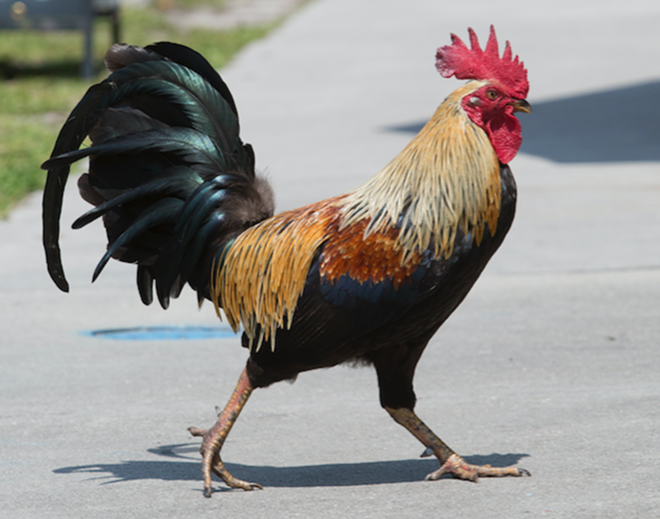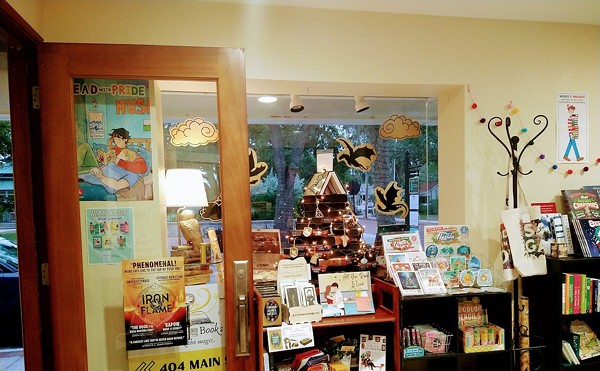
History fears the roosters.
That’s not a metaphor; the Ybor City Museum State Park has one of the few state-sanctioned cats, named History, and he’s petrified of the peeps of roosters roaming the streets. As far as cats go, History’s tiny, which means the roosters outweigh him. He lives in the garden on the museum grounds.
“There are bands of roving chickens everywhere,” McCoy says. “They’re pretty aggressive.”
“He’s scared witless of the roosters,” says Elizabeth McCoy, curator of the Ybor City Museum Society. “He hides under the table from them, they chase him. They’ll charge him if he gets too close.”
If History doesn’t love the roosters, well, historically, Ybor City does.
“People claim that the chickens that were in Ybor six or seven years ago were the [descendants] of the founding immigrants,” McCoy says, although when pressed, the museum could not produce any provenance on the birds in question.
“We don’t have any documentation that establishes them as related to the historic chickens we had in Ybor,” McCoy admits. Nevertheless, long-time Yborians and newcomers alike crow over the beauty of the roosters strutting about town.
When a chicken catcher came to town in 2008, locals — including a man locals called “Rooster Tommy” — cried fowl (sorry, we had to do it). The mayor at the time, Pam Iorio, spoke in favor of the chickens. In the past, the town has seen rooster funerals, too.
Roosters are the unofficial mascot of Ybor City. Period. But still... In the five and a half years since locals protested the rooster catcher, things have changed for Ybor — and for the flocks free-ranging its streets.
“Whatever’s happened in the last few years, they’ve blossomed,” McCoy says. On a recent walk between CL headquarters and the museum — a seven-minute excursion — no less than 10 roosters, twice as many hens, and innumerable chicks showed their beaks.
“There are bands of roving chickens everywhere,” McCoy says. “They’re pretty aggressive. We’ve had roosters chase visitors. People [who work in Ybor] will come eat their lunch in the gardens and the roosters will get a litte too aggressive with them. We’ve actually had people get chased in the garden. They’ll get charged; the chickens will rush at people.”
The roosters, she says, grow accustomed to handouts, which worsens the aggression, but according to chicken husbandry websites, rooster aggression is a problem no matter what.
Roosters tend to be territorial and, according to a project manager at BackyardChickens.com, they will also defend their peeps from any threats.
“A threat to a rooster may be quite different than what we perceive as a threat,” the website project manager posts. “We need to understand and respect this instinct. A small child could be perceived as a threat in a rooster’s eyes.”
And so Ybor arrives at the intersection of “cute” and “chilling,” where those striking cock tails and plumes turn into threats and the same people initially charmed by the roosters feel apprehensive when they see roosters parading down 19th Street.
“We’ve put up signs about how to interact with the chickens,” says McCoy, who estimates the neighborhood has several hundred free-ranging fowl.
Tampa — like most cities that allow people to keep chickens — doesn’t allow backyard roosters, only hens, but because the roosters don’t belong to anyone, Hillsborough County Pet Resources has no jurisdiction. Susan Wenrick, District V Supervisor for Tampa’s Neighborhood Empowerment Department (other cities call this code enforcement), says she knows of no rooster-related complaints.
Not everyone has had rooster-related troubles. Lori Rosso, the new executive director of the Ybor City Chamber of Commerce, says she loves them. That’s a good thing, because the poultry tends to loiter in Centennial Park, across the street from the chamber offices.
“They’re great,” she says. “You’re used to them at dusk around the casita. I find them endearing. They startle me when I’m coming down the casita steps and they run out from underneath the stairs, but it makes me laugh.”
Others say they don’t live or work close enough to the roosters for the fowl to be problematic.
“They stay on their side of Ybor and not mine,” says Michael Murphy of Silver Meteor Gallery. “They seem to stay south of 7th Avenue. Because of all the truck traffic, they seem to stay on their side of the road.”
Feel free to make whatever joke you wish.

















